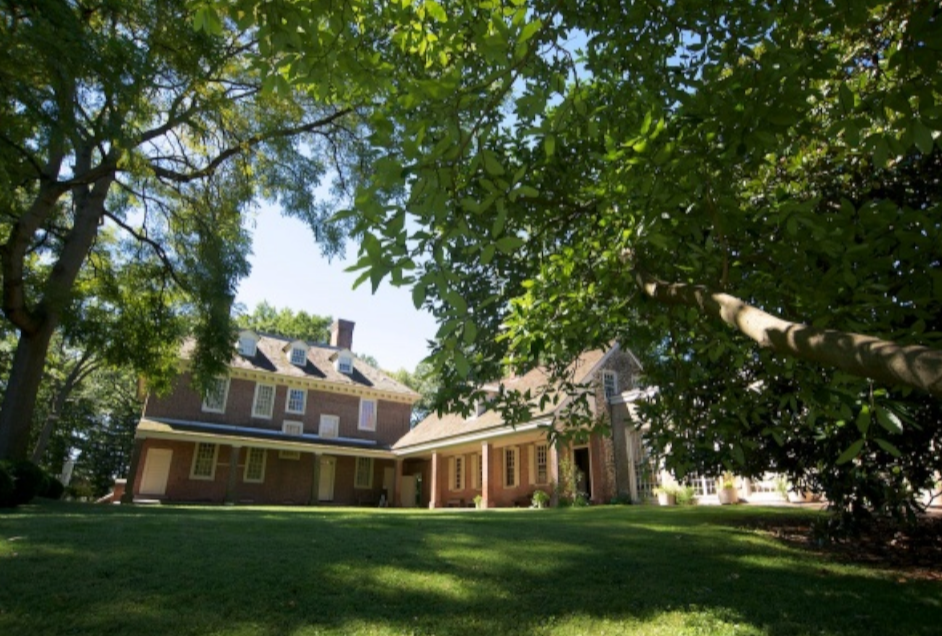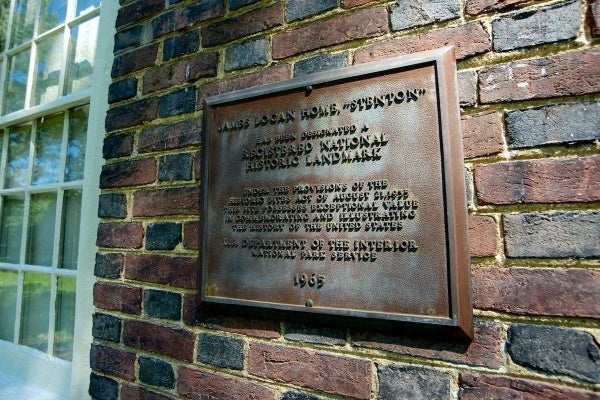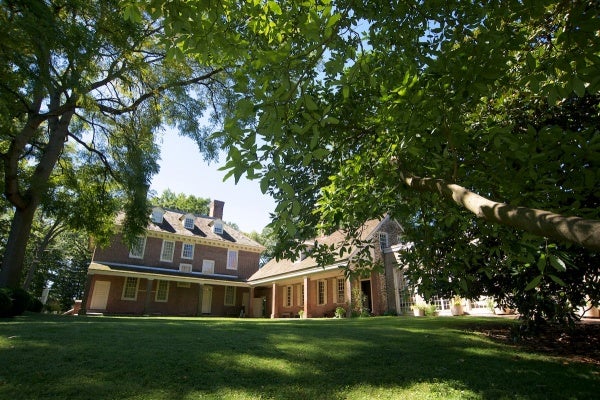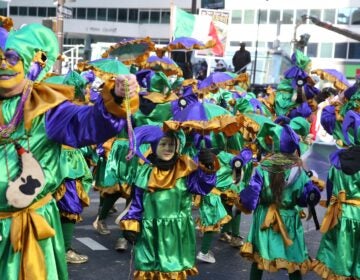Stenton mansion to undergo $800K landscaping ‘rejuvenation’
A Germantown property that is central to the history of Pennsylvania is about to get a re-do — one that will reflect 100 years of change at the site, while reconnecting with the contemporary community around it.
Stenton, the country mansion built in 1730 by James Logan, has been well preserved as a museum where visitors can learn about the secretary to William Penn and Logan’s vital role in the formation of the commonwealth.
The Georgian-style house and its outbuildings have been carefully administered since 1899 by an organization with the exhaustive early-American moniker, The National Society of The Colonial Dames of America in the Commonwealth of Pennsylvania.
But an overgrown green curtain of trees and shrubs hide the site from the neighborhood, and the grounds offer little understanding of what once existed around the historic buildings.
Last year, the Dames, who have tended the gardens within the site, decided to revive the greater landscape in its 18th to 19th century styles and recapture its full impact and beauty. They hired Claudia Levy to start the transformation.
“My work, to begin with, is to do a master plan for the site that takes into account all of the history that has gone on here — all of the different periods, evolutions and uses of the landscape, and what it needs to be going forward as part of the programming at Stenton,” Levy said.
More than a plaque
A Harvard-educated landscape architect based in Germantown, Levy began her focus on historic landscape restoration midway in her career.
Before that, she had worked with a Connecticut firm that focused on high-end estates. Those were projects that she found “a bit soulless, that had more to do with money and prestige than with anything significant, especially as how it had to do with the land and how it was used and valued by people over time.”
Historic preservation, traditionally, has focused on old structures and has been “the domain of the architects,” Levy said. That has changed over the past 20 years, and “there is an understanding now that sometimes what you need to preserve has no structures on it at all.”
Still, there tend to be formulaic approaches to historic landscapes.
“If you want to commemorate it, you plop the plaque down, or put names on the bricks. What is really needed is the kind of design thinking that goes on in other projects, but applied to the specifics of the historic garden,” Levy said.
Horticultural history
When Stenton was first created, it was a plantation that covered 500 acres.
Aside from his work as land administrator, negotiator and tax collector, James Logan was a leading botanical scientist who shared knowledge with John Bartram and Benjamin Franklin.
His older son William maintained the property after James’ death, and pursued his own horticultural interests in exotic plants. His son, George, turned Stenton into a model farm of progressive agriculture.
In 1911, Colonial Dame Letitia Ellicott Wright began working with landscape architect and Logan descendant John Caspar Wister on a plan for re-creating a “Colonial Garden” at Stenton. In 1913, the garden was the setting for the founding and first meeting of a national organization, the Garden Club of America.
Last May, Stenton, which now covers 2.6 acres, welcomed the 100th anniversary of the Garden Club with a gathering of members from across the U.S. It was preparation for that centennial visit that prompted serious discussion of restoring the Stenton landscape.
“We are not using the word restoration,” said Stenton curator Laura Keim. “We are not trying to make it look like the original garden. We’re calling it a rejuvenation.
“It represents an intervention to the site by the Colonial Dames to put their stamp on this place. But it’s also an effort to honor the Logan family and their interest in horticulture and gardens in the past.”
The plan
One of the primary sites of the rejuvenation at Stenton will be what is now being called the Colonial Revival Garden.
“It is not a garden that was actually here in Colonial times,” Levy explained. “It’s very much an imagined kind of garden.”
The typical Colonial garden would be a rectilinear space and include both edible and ornamental plants. It would include a fence to keep out animals, large and small. Border boxwoods planted in the 1900s by Wright and Wister will be preserved in the new plan. Some of the annual and perennial beds may be switched to ground covers or other low-maintenance plantings.
“But the Dames like their gardens to be pretty and they like all the color, so we’re looking for a balance there,” Levy said.
Another important element in the master plan is the screen planting, which in 1911 meant blocking some of the view of the industrial landscape that had been built around Stenton with the arrival of the railroad in the mid-19th century.
Wister had been concerned about those views out of the property, and designed a screen planting of native species that hid the factories across the street.
The Wister plan provides insight into the early 20th century role of Stenton, and the 21st century master plan will restore aspects of it.
“But we also want to keep some aspects open so people can see what’s here. We don’t want to screen everything off. We want to create better connections into the neighborhood,” Levy explained.
Other aspects of the master plan will include a more welcoming entrance into Stenton and a better circulation of vehicles and people through the grounds that provides access to all of the landscape and information about sites beyond the fence, including the former Logan family burial ground, which had been paved over in the mid-1900s in response to vandalism, in Stenton Park.
The budget
Initial funding for the rejuvenation at Stenton came from the Hamilton Foundation to cover much-needed tree pruning and the first design phase of the master plan.
“What we’re doing right now is fundraising for the restoration of the Colonial Revival Garden,” said Levy, who hopes to get the garden growing in the spring and finished over the course of next year.
The overall project will cost from $600,000 to $800,000.
Keim said the funds will be sought from “multiple sources, a combination of grant funding, as well as private funding. It’s probably something that will be phased, and possibly over a decade because of the nature of gardens.”
The main thing, Levy said, is “to expand the message and story to include something about the exterior and the landscape – what it meant in the Colonial period, what it meant in the 19th century, and how it informed what was going on in this house, starting with James Logan, going up to the Garden Club, and the stewardship of the Dames over the last 100 years.”
NewsWorks has partnered with independent news gatherer PlanPhilly to provide regular, in-depth, timely coverage of planning, zoning and development news. Contact Alan Jaffe at alanjaffe@mac.com.
WHYY is your source for fact-based, in-depth journalism and information. As a nonprofit organization, we rely on financial support from readers like you. Please give today.
Stenton mansion to undergo $800K landscaping ‘rejuvenation’

A Germantown property that is central to the history of Pennsylvania is about to get a re-do — one that will reflect 100 years of change at the site, while reconnecting with the contemporary community around it.
Stenton, the country mansion built in 1730 by James Logan, has been well preserved as a museum where visitors can learn about the secretary to William Penn and Logan’s vital role in the formation of the commonwealth.
The Georgian-style house and its outbuildings have been carefully administered since 1899 by an organization with the exhaustive early-American moniker, The National Society of The Colonial Dames of America in the Commonwealth of Pennsylvania.
But an overgrown green curtain of trees and shrubs hide the site from the neighborhood, and the grounds offer little understanding of what once existed around the historic buildings.
Last year, the Dames, who have tended the gardens within the site, decided to revive the greater landscape in its 18th to 19th century styles and recapture its full impact and beauty. They hired Claudia Levy to start the transformation.
“My work, to begin with, is to do a master plan for the site that takes into account all of the history that has gone on here — all of the different periods, evolutions and uses of the landscape, and what it needs to be going forward as part of the programming at Stenton,” Levy said.
WHYY is your source for fact-based, in-depth journalism and information. As a nonprofit organization, we rely on financial support from readers like you. Please give today.


























